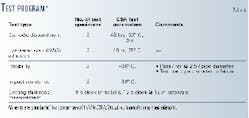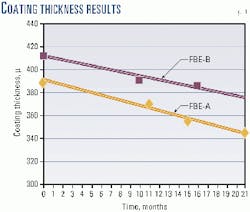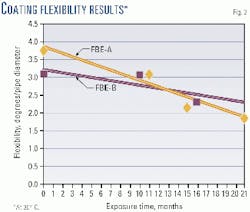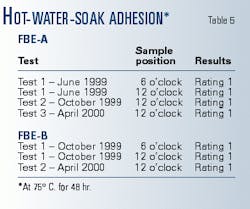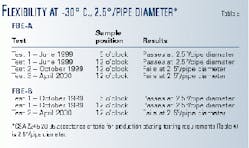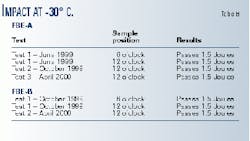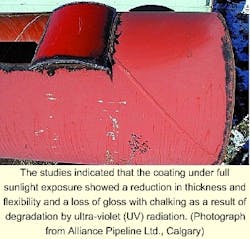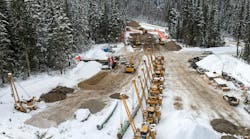Studies undertaken for the 3,700-km Alliance Pipeline to quantify the effects of sunlight on fusion-bonded epoxy (FBE) coating on stockpiled line pipe indicated that the coating under full sunlight exposure showed a reduction in thickness and flexibility and a loss of gloss with chalking as a result of degradation by ultra-violet (UV) radiation.
There were no significant differences, however, in cathodic disbondment, adhesion, and impact properties in the samples.
Sections of production pipe stockpiled in Alberta and North Dakota for the project were selected for testing. The program was to evaluate the coating properties at periodic exposure intervals of nearly 2 years.
The coating was tested at both full sunlight exposure (12 o'clock position) and with minimal exposure (6 o'clock position).
The properties evaluated included residual coating thickness, cathodic disbondment, adhesion, flexibility, and impact.
Tests were carried out following procedures as outlined in the CSA Z245.20-98 standard. Results were collected after 15-21 months of aging.
The program was prompted by the fact that, although sunlight exposure is known to cause degradation in polymer coatings, quantitative data relating exposure to mechanical and corrosion properties are missing.
Thus, it is very difficult for pipeline operators to assess the impact of stockpiling coated pipe on project economics and pipeline integrity.
Alliance pipe
In 1999, Alliance Pipeline began construction of a new pipeline of mainline and lateral systems with completion planned for October 2000.
The large scale of this project meant that the pipe had to be manufactured and coated in 1998 and stockpiled in the field.
Sections of pipe of about 9-ft each were cut from pipe that had been initially stored in two different locations in the field and sent to Calgary for evaluation.
Two different types of FBE coatings were evaluated:
- FBE-A: 1,067 mm OD x 11.4 mm WT, Grade 483, Cat II; coating date: July 11, 1998; stored in Grovedale, Alta., until May 1999.
- FBE-B: 914 mm OD x 15.8 mm WT, Grade 483, Cat II; coating date: Dec. 3, 1998; stored in Towner, ND, until August 1999.
Shaw Pipe's technology and development group evaluated the coating properties. The testing program started in June 1999 and continued at periodic exposure intervals with completion in October 2000.
Each coating type was initially tested at both 6 o'clock and 12 o'clock positions. All subsequent tests were conducted at the 12 o'clock position (the maximum sunlight exposure), with the 6 o'clock position (minimum sunlight exposure) serving as a reference.
This article discusses the results of this study.
Testing procedure
Sampling points were marked at 12-in. intervals (30 cm) along each pipe section.
The coating thickness was measured at these marked points. The segments of marked pipe were subsequently cut off as required for the testing as outlined presently.
Test samples were taken from the 12 o'clock position over the duration of the program. Table 1 shows test frequency.
Initially, test samples were taken for reference purposes from the 6 o'clock position.
Table 2 summarizes the test program, consisting of the following tests:
Coating thickness measurements were taken every 12 in. along the length of the pipe at the 12 and 6 o'clock positions, using a Positector 6000 thickness gauge. The precision of the Positector 6000 gauge is ± 2 mm.
Cathodic disbondment tests (48 hr at 65° C.) were conducted in accordance with CAN/CSA-Z245.20-98 standard.
Adhesion tests (48 hr at 75° C.) were conducted in accordance with CAN/CSA-Z245.20-98 standard.
Impact-resistance tests (at -30° C.) were conducted in accordance with CAN/CSA-Z245.20-98 standard.
Flexibility tests (at -30° C.) were conducted in accordance with CAN/CSA-Z245.20-98 standard.
Additional tests were carried out to determine the failure point and the maximum bending allowable.
Results
Here are the completed test results:
- Coating-thickness measurements. Table 3 and Fig. 1 present the coating-thickness results taken from FBE-A and FBE-B at the selected time intervals.
A reduction in the gloss was apparent at the 12 o'clock position in both FBE-A and FBE-B coatings.
- Cathodic disbondment. Table 4 presents the results of the cathodic-disbondment tests carried out at 65° C. and 48 hr.
No meaningful difference was observed in cathodic disbondment tests results from the 6 and 12 o'clock positions between the initial and final tests.
The CSA Z245.20-98 acceptance criterion for production coating testing requirements is 13 mm.
- Adhesion. Table 5 presents the results of the adhesion tests carried out at 75° C. and 48 hr. Rating No. 1 was observed for all samples tested showing no difference between the initial and final tests. The CSA Z245.20-98 acceptance criterion for production coating test is a rating of 1 to 3.
- Flexibility. Tables 6-7 and Fig. 2 present the results of the flexibility tests carried out at -30° C. CSA Z245.20-98 acceptance criterion for production coating test is 2.5°/pipe diameter.
The flexibility of the coating degraded from June to October 1999. The coatings sampled in April 2000 no longer passed the minimum CSA requirement of 2.5°/pipe diameter. FBE-A also failed at 2.2°/pipe diameter but passed at 1.9°/pipe diameter (21-month exposure).
FBE-B failed at 2.5°/pipe diameter but passed at 2.3°/pipe diameter flexibility test (16-month exposure).
- Impact. Table 8 presents the results of the impact tests carried out at -30° C. All samples passed the test at 1.5 Joules.
The CSA Z245.20-98 acceptance criterion for production-coating testing requirement is 1.5 Joules impact resistance with no holidays.
What was learned
Approximately 1.0-2.0 mils loss in coating thickness and a visible reduction in gloss were observed at the 12 o'clock position after 16-21 months' exposure.
No measurable difference was ob served in cathodic disbondment or hot-water-soak tests conducted at 48 hr between the initial and final tests conducted.
The most severe effect was noted in the marked reduction in flexibility, with both FBE-A and FBE-B failing the 2.5°/pipe diameter flexibility test.
There is no difference in the impact resistance for both FBE coatings (passes 1.5 Joules between the initial tests and final tests).
Based on the interim test results, pipe stored outside for longer than 1 year should be protected against UV degradation.
In future research work, cathodic-disbondment tests and hot-water-soak tests should also be conducted at longer intervals (28 days or longer) to determine any measurable degradation over these periods.
The impact testing should be conducted to failure to quantify the effects on impact properties.
Acknowledgments
The authors would like to thank Alliance Pipeline Ltd. and Shaw Pipe Protection Ltd. for their contributions to this article.
The authors
Matt Cetiner is president of Anteris Corrosion Inc., Calgary, with 20 years of experience in cathodic protection, coatings, and integrity. He holds a BSc in metallurgy and an MSc in corrosion science from the University of Manchester Institute of Science & Technology, and he is a NACE-certified cathodic protection specialist and a registered professional engineer in Alberta.
Peter Singh is a senior technical advisor with Shaw Pipeline Protection Ltd., Calgary. Previously, he was manager of Shaw's technology and development laboratories. He holds a PhD in chemical engineering from McGill University, Montreal, and is a registered professional engineer in Alberta.
Alan Gilroy-Scott is president of Integrity Management, Calgary and was responsible for materials engineering and quality management for the Alliance pipeline project from 1996 to 2001. He holds a metallurgical engineering diploma, NSW Australia, and is registered professional engineer in Alberta and Saskatchewan.
Jake Abes is president of Pipeline Safety Consulting Inc. and chair of the Canadian Standards Association CSA Z662 Technical Committee. He holds a BEng (1979) and an MEng (1988) from Carleton University, Ottawa.
Based on a presentation to the International Pipeline Conference 2000, Oct. 1-5, 2000, Calgary.
